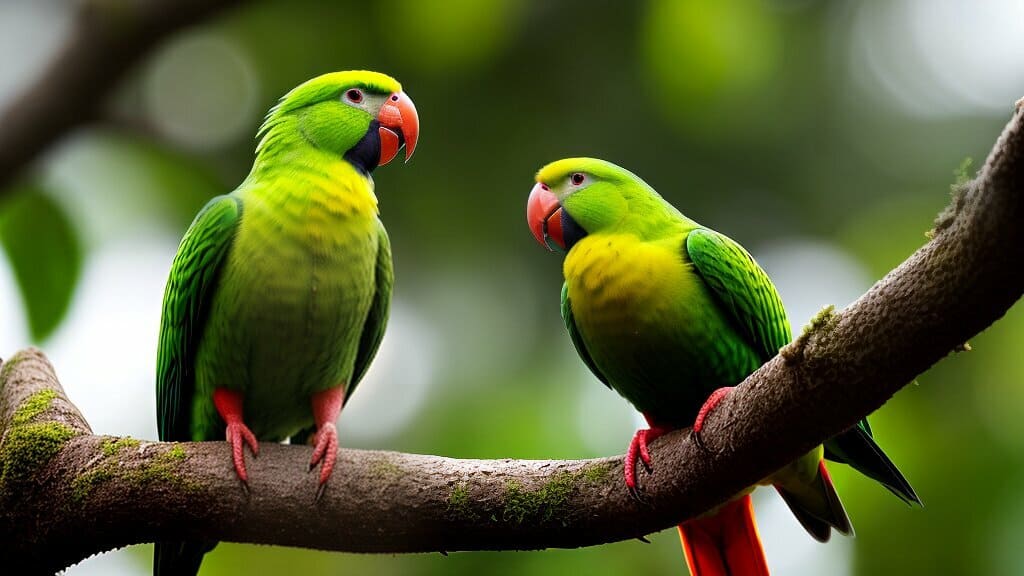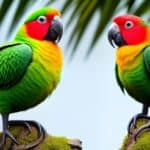If you’re a kakariki owner, you may wonder whether feeding your feathery friend melon is safe. After all, birds have unique dietary needs, and not all foods are suitable for them. In this article, we will explore whether kakarikis can eat melon and provide valuable insights on maintaining a balanced and nutritious diet for your pet bird.
Can Kakarikis Eat Melon? Yes, Kakarikis can safely consume melon. This fruit is an excellent source of vitamin C, which is essential for their health. However, the portion size should be controlled as melons have high water and sugar content. Too much can potentially lead to diarrhoea or unhealthy weight gain. It’s crucial to remove seeds as they can present a choking hazard.
As a responsible pet owner, it’s important to understand what foods are safe and healthy for your kakariki. By taking the time to research and learn about your bird’s dietary needs, you can help ensure that they thrive and enjoy a long and happy life.
Key Takeaways
- Feeding your kakariki a balanced diet is crucial for their health and well-being.
- Not all fruits are safe for kakarikis, but melon can be a healthy treat when prepared and offered appropriately.
- Maintaining variety in your bird’s diet and consulting with a veterinarian for dietary recommendations are key to ensuring optimal nutrition.
Understanding Kakariki Diet and Nutrition
Kakarikis have specific dietary needs to keep them healthy and happy. A well-balanced diet will ensure your pet bird receives the vital nutrients for optimal health and longevity.
What can Kakarikis eat?
Kakarikis can eat various foods, including fruits, vegetables, seeds, and nuts. They also require a high-quality pellet or seed mix to ensure they receive the necessary vitamins and minerals.
What are the key nutrients for Kakariki nutrition?
The key nutrients that Kakarikis need for optimal health and well-being include:
- Protein for muscle growth and repair
- Fresh fruits and vegetables for essential vitamins and minerals
- Fats for energy and healthy feathers
- Calcium for strong bones and beaks
- Vitamin A for good eyesight and a healthy immune system
- Vitamin D for calcium absorption and strong bones
It’s important to provide a variety of foods to ensure your Kakariki receives all the necessary nutrients.
How often should Kakarikis be fed?
Kakarikis should always have access to food to graze as they please. However, monitoring their food intake is important to ensure they don’t overeat or become overweight.
Do Kakarikis need supplements?
Generally, Kakariki shouldn’t require supplements if they receive a varied and balanced diet. However, individual needs may vary, and it’s always best to consult a veterinarian for personalised dietary recommendations.
Exploring the Benefits of Melon for Kakarikis
When offered in moderation, melon can be a healthy addition to your kakariki’s diet. Not only is it a tasty treat for these birds, but it also holds potential health benefits.
| Nutrient | Amount in Melon | Potential Benefits |
|---|---|---|
| Vitamin A | High | Supports vision and immune system |
| Vitamin C | High | Supports immune system and antioxidant function |
| Potassium | High | Supports heart and muscle function |
| Fiber | Moderate | Promotes digestive health and satiety |
Melon can help support the immune system and promote healthy vision with its high vitamin A and C content.
The fruit’s potassium content also supports heart and muscle function. Additionally, the fiber in melon can promote digestive health and help keep your kakariki feeling full and satisfied.
It is important to note that melon should not be the sole source of these nutrients in your kakariki’s diet. Variety is key to providing a balanced and nutritious diet for your bird.
Overall, offering melon as a treat in moderation can give your kakariki potential health benefits while adding some variety to their diet.
Types of Melon Safe for Kakarikis
When feeding your kakariki melon, choosing the right type is important.
Some melons contain substances that can be harmful to birds, while others are safe and even nutritious. Here are some melon varieties that are safe for kakarikis to consume:
| Melon Type | Description |
|---|---|
| Watermelon | A popular melon with a sweet and fragrant flavour. It’s high in vitamin A and C, potassium, and fibre. |
| Honeydew Melon | A popular melon with a sweet and fragrant flavour. It’s high in vitamins A and C, potassium, and fibre. |
| Galia Melon | A sweet and mild-tasting melon with pale green flesh. It’s a good source of vitamin C and contains potassium and calcium. |
| Cantaloupe | An aromatic and sweet melon with yellow-green flesh. It’s packed with vitamin C, potassium, and fibre. |
When introducing melon to your kakariki’s diet, start with small amounts and gradually increase as they become accustomed to the new food. Always wash and remove the rind and any seeds before feeding your bird.
Preparing Melon for Kakarikis
Feeding melon to your kakariki requires proper preparation to ensure their safety and enjoyment. Here are some tips:
- Remove the seeds: Kakarikis should not consume melon seeds as they can cause digestion problems. Make sure to scoop out all of the seeds before serving.
- Remove the rind: The tough outer skin of the melon can be difficult for kakarikis to digest. Cut it away and only offer the soft, fleshy part of the melon.
- Serve in small portions: While melon is a healthy treat, too much can upset your bird’s stomach. Start by offering small pieces and monitor their reaction before increasing the amount.
- Serve fresh: Melon should be served fresh and not left out for long periods. Discard any uneaten portions after a few hours to avoid spoiling.
Tip: Offer melon as a special treat or reward for your kakariki’s good behaviour, rather than a regular part of their diet. Variety is key to a balanced diet.
Potential Risks and Considerations
While melon can be a healthy and safe treat for kakarikis, it’s important to be aware of potential risks and considerations when feeding this fruit to your pet bird.
Seeds
Many melons, such as watermelon and cantaloupe, contain seeds that can pose a choking hazard for kakarikis. When feeding your bird melon, remove all seeds and any tough outer skin they could choke on.
Sugar Content
Melon has a high sugar content, which can harm kakarikis when consumed in excess. While a small amount of melon can be a nutritious treat for your pet bird, too much can lead to obesity and related health issues.
Introducing New Foods
When introducing any new food to your kakariki’s diet, it’s important to do so gradually and in small amounts. This will allow their digestive system to adjust and prevent any adverse reactions. If your bird shows signs of digestive upset, such as vomiting or diarrhea, discontinue feeding them melon and consult with a veterinarian.
Monitoring Your Bird’s Response
As with any food, it’s crucial to monitor your kakariki’s reaction to melon and adjust their diet accordingly. If you notice any changes in their behaviour or health after introducing melon, consult with a veterinarian for guidance.
Following these precautions and properly preparing melon, you can safely incorporate this delicious fruit into your kakariki’s balanced diet.
Ranking The Different Varieties of Melon for Kakariki Parrots
As we have already discussed, melon can have high sugar and water content, which can cause issues for your parrot.
This table ranks the most common types of melon in order of suitability based on their water and sugar content.
| Rank | Type of Melon | Overview |
| 1 | Galia | Galia melons have moderate sugar and water content, making them a relatively balanced option for a kakariki parrot. |
| 2 | Honeydew | Honeydew melons have moderate sugar content and high water content. While they are a suitable option in moderation, excessive consumption may lead to diarrhoea. |
| 3 | Cantaloupe | Cantaloupes have slightly higher sugar content than Galia melons but are still relatively moderate. They have a good water content as well, but overconsumption might cause issues. |
| 4 | Watermelon | Watermelons have high water content and moderate sugar content. While they can be offered as a treat, excessive consumption may lead to diarrhea due to their high water content and can contribute to obesity due to their sugar content. |
Balancing Melon with Other Foods in Kakariki Diet
While melon can provide a nutritious treat for your kakariki, it should be balanced with other foods to ensure your bird receives all the necessary nutrients for optimal health. Variety is key to a healthy diet.
In addition to melon, you can offer your kakariki a range of fruits and vegetables. Safe fruit options include apples, pears, berries, and bananas. Vegetables such as broccoli, carrots, and leafy greens like kale and spinach are also great additions to their diet.
It’s important to ensure that your kakariki’s diet includes enough protein and other essential nutrients, which can be provided through foods like boiled egg, cooked chicken, and commercially available bird food. Always research the specific nutritional requirements of your bird species to tailor their diet accordingly.
Remember to offer different types of foods in small quantities to prevent boredom and encourage foraging behaviour. Offering a variety of colours and textures can make mealtime more stimulating and enjoyable for your feathered friend.
- Offer a variety of fruits and vegetables in addition to melon
- Ensure their diet includes enough protein and essential nutrients
- Research specific nutritional requirements for your bird species
- Offer different types of foods in small quantities to prevent boredom
By incorporating a variety of foods and nutrients into your kakariki’s diet, you can help ensure a healthy and happy bird. Monitor their reaction to new foods and consult a veterinarian for specific recommendations.
Monitoring Your Kakariki’s Reaction to Melon
Introducing new foods into your pet bird’s diet requires careful observation. To determine your kakariki’s reaction to melon, start by offering a small amount and watching their behaviour for any signs of distress or discomfort.
Note: Avoid feeding your kakariki too much melon at once, which can lead to digestive issues.
If your kakariki appears to enjoy the melon and shows no signs of adverse reactions, you can gradually increase the amount over time. However, if they exhibit any negative symptoms, such as vomiting or diarrhoea, stop feeding them melon immediately.
It’s important to remember that every bird is unique, and what works for one may not work for another. Be patient and watch your kakariki’s behaviour as you introduce new foods into their diet.
Other Fruits and Vegetables Kakarikis Can Enjoy
While melon can be a tasty addition to a kakariki’s diet, they can safely enjoy many other fruits and vegetables. Offering a variety of foods is crucial for a balanced diet and to prevent boredom with the same meals.
Some safe options for kakarikis include:
- Berries, such as strawberries, blueberries, and raspberries
- Leafy greens, such as spinach, kale, and lettuce
- Carrots and other root vegetables
- Small pieces of apple or pear (without seeds)
- Cucumbers and zucchini
Remember always to rinse and chop fruits and vegetables into small, manageable pieces. Avoid offering foods high in sugar or salt and any foods toxic to birds.
A varied diet can help support your kakariki’s overall health and well-being. Consult a veterinarian or avian specialist for specific dietary recommendations tailored to your bird’s needs.
Consulting a Veterinarian for Dietary Recommendations
While this article provides general guidelines for feeding melon to your Kakariki, it’s important to consult a veterinarian for specific dietary recommendations. Veterinarians can provide tailored advice based on your bird’s individual needs, and help ensure that their diet is balanced and meets all necessary nutritional requirements.
Tips for Maintaining a Healthy Kakariki Diet
Providing your kakariki with a balanced and nutritious diet is essential for their health and well-being. Here are some tips to help you maintain a healthy diet for your pet bird:
- Offer a variety of foods: Kakarikis thrive on variety in their diet. Make sure to offer a mix of fruits, vegetables, and protein-rich foods to provide them with a range of essential nutrients.
- Use proper portion sizes: Kakarikis are small birds that require small portions. Offer a few pieces of fruit or vegetables at a time, or a small serving of protein-rich food.
- Rotate foods regularly: To ensure that your kakariki gets a range of nutrients, rotate the foods you offer regularly. This can also help prevent boredom and encourage them to eat more.
- Limit sugary or fatty foods: While offering treats like melon is okay, sugary or fatty foods should be limited in your kakariki’s diet. These types of foods can lead to obesity and other health problems.
- Consult a veterinarian: If you have any concerns about your kakariki’s diet or nutritional needs, it’s always best to consult a veterinarian specialising in avian medicine.
Remember, a healthy diet is key to keeping your kakariki happy and thriving. With a little effort and attention, you can provide your pet bird with a varied and nutritious diet that supports their health and well-being.
Conclusion
In conclusion, feeding melon to your kakariki in moderation can be a safe and enjoyable addition to their diet. It’s important to understand these pet birds’ specific nutritional needs and dietary requirements and offer them a balanced array of foods that promote optimal health and well-being.
When preparing melon for your kakariki, remove any seeds or skin and cut it into small, bite-sized pieces. While melon can offer a range of benefits, it should not be the only food in their diet. Be sure to include other fruits and vegetables, as well as proteins and grains, to provide a varied and balanced diet.
If you have any concerns about your kakariki’s diet or want specific dietary recommendations, it’s always best to consult with a veterinarian who can offer tailored guidance. You can give your kakariki the nutrients they need to thrive and lead a happy, healthy life with patience and care.
FAQ
Q: Can Kakarikis Eat Melon?
A: Kakarikis can safely consume melon when prepared and offered appropriately.
Q: What is the importance of a balanced diet for kakarikis?
A: A balanced diet is essential for kakarikis’ overall health and well-being, providing them with the necessary nutrients to thrive.
Q: What can kakarikis eat?
A: Kakarikis can eat various foods, including fruits, vegetables, pellets, and seeds.
Q: Are there any benefits of feeding melon to kakarikis?
A: Melon can provide essential vitamins, minerals, and hydration for kakarikis, promoting their health and enjoyment.
Q: Which types of melon are safe for kakarikis?
A: Watermelon, honeydew melon, galia melon, and cantaloupe are safe melon varieties for kakarikis.
Q: How should melon be prepared for kakarikis?
A: Melon should be cut into small, bite-sized pieces and served without seeds or the outer skin.
Q: What potential risks and considerations are associated with feeding melon to kakarikis?
A: Seeds and skin of melon can pose choking hazards for kakarikis, so removing them before serving is important.
Q: How should melon be balanced with other foods in a kakariki’s diet?
A: Melon should be offered as a treat alongside a balanced diet that includes other fruits, vegetables, pellets, and seeds.
Q: How should a kakariki’s reaction to melon be monitored?
A: When introducing melon to a kakariki’s diet, observe their response and make any necessary adjustments to ensure their well-being.
Q: What other fruits and vegetables can kakarikis enjoy?
A: Kakarikis can also enjoy safe options such as apples, berries, leafy greens, carrots, and broccoli.
Q: Should I consult a veterinarian for dietary recommendations for my kakariki?
A: It’s always best to consult a veterinarian for specific dietary recommendations tailored to your kakariki’s needs.
Q: What are some tips for maintaining a healthy kakariki diet?
A: Offer a variety of foods, ensure proper portion sizes, and consult with a veterinarian to maintain a healthy kakariki diet.



Have comments or questions about this article? Then get involved!
Spotted an error or something we have missed? Let us know